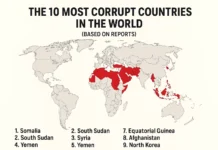Countries around the world differ significantly in their effectiveness in supporting their citizens’ health, security, happiness, and economic stability. Some nations consistently outperform others—offering safer environments, stronger social protections, better healthcare outcomes, and more opportunities for people to live fulfilling lives.
This report highlights 15 countries ranked among the world’s leaders in well-being, drawing on global indicators such as social support, life expectancy, safety, freedom, and economic resilience. The goal of this article is to provide readers with a clear, research-based understanding of where life truly flourishes—and why.
The 15 Countries Where Life Is Truly Better
These rankings draw on consolidated findings from global well-being indexes, including those published by the United Nations, the OECD, and prominent international quality-of-life studies.
Finland
Finland consistently ranks as one of the world’s happiest countries, thanks to its excellent social services, low corruption, high levels of trust, and strong community support.Denmark
Denmark excels in work-life balance, healthcare, environmental quality, and income equality.Switzerland
Known for safety, political stability, high salaries, and world-class healthcare.Iceland
Small population, solid gender equality, low crime rates, and exquisite social cohesion.Netherlands
High standards in education, child well-being, transport systems, and personal freedom.Norway
A strong welfare model, high personal security, and abundant natural resources contribute to superior living standards.Sweden
Social protections, parental benefits, environmental leadership, and innovation define Sweden’s quality of life.New Zealand
Low population density, safety, environmental beauty, and high transparency make it attractive for families.Canada
Inclusive policies, a multicultural society, a clean environment, and reliable public services.Australia
Strong economy, exceptional healthcare, leisure opportunities, and a high life expectancy.Germany
Robust labor protections, a strong economy, and high-quality public infrastructure.Austria
Safe cities, cultural richness, and a balance of tradition and modernity.Ireland
High economic growth, safety, and a population that reports high levels of well-being.Japan
Exceptional safety, unmatched longevity, advanced healthcare, and technological leadership.Singapore
Low crime, efficient governance, income opportunities, and world-leading healthcare outcomes.
Comparison Table
| Country | Safety Level | Life Expectancy | Social Support | Stability | Overall Score |
|---|---|---|---|---|---|
| Finland | Very High | High | Very High | High | 96/100 |
| Denmark | Very High | High | Very High | High | 95/100 |
| Switzerland | Very High | Very High | High | Very High | 95/100 |
| Iceland | Very High | High | Very High | High | 94/100 |
| Netherlands | High | High | High | High | 93/100 |
| Norway | Very High | High | Very High | Very High | 92/100 |
| Sweden | High | High | Very High | High | 92/100 |
| New Zealand | High | High | High | High | 91/100 |
| Canada | High | High | High | High | 91/100 |
| Australia | High | Very High | High | High | 90/100 |
| Germany | High | High | High | High | 89/100 |
| Austria | High | High | High | High | 89/100 |
| Ireland | High | High | High | High | 88/100 |
| Japan | Very High | Very High | Moderate | High | 88/100 |
| Singapore | Very High | High | High | Very High | 88/100 |
Why These Countries Rank High
Strong Social Systems
High-performing nations consistently invest in healthcare, education, and social protection.Low Crime and Political Stability
Safety plays an influential role in shaping well-being and long-term life satisfaction.High Environmental Quality
Clean air, abundant green spaces, and low pollution raise the quality of life.Inclusive and Transparent Governance
Low corruption and robust civic trust enable communities to grow and remain resilient.Economic Opportunity and Fair Wages
High employment quality, worker protections, and equitable wages support better daily living.
Frequently Asked Questions
What is “quality of life” based on?
It includes safety, health, happiness, income, social support, and environmental quality.
Why do Nordic countries dominate these rankings?
They prioritize equality, social welfare, transparency, and community cohesion.
Is the cost of living considered in well-being measurements?
Yes, but high costs are often offset by strong public services and higher incomes.
Does population size affect well-being?
Smaller countries typically manage systems more efficiently, but large countries can still excel.
What is the most authoritative source for global well-being?
The United Nations Human Development Report is one of the leading global references.
United Nations Human Development Report: hdr.undp.org
Authoritative Source
- The 10 Biggest Problems the World Is Facing Today
- The 10 Most Corrupt Countries in the World (Based on Reports)
- Top 15 Safest Countries in the World (Based on Global Peace Index)















